| 
Would you like to really experience Japanese culture?
I mean, riding a shinkansen or blowing 1,000 yen
on Pachinko is one thing, but these experiences,
although interesting, lack a great deal of cultural
depth. To really get inside Japan and the Japanese
psyche, one really needs to explore Japanese fine
art, in this case, ikebana or as it translates literally
‘live flowers’.
An art form which originated around the 6th century,
ikebana was originally practiced as a ritual offering
made to the heavens by Buddhist monks. These days
the once exclusive art of ikebana has developed
into an art form practiced by many. Unlike floral
arranging practiced in Europe and the West, the
more spiritual Japanese approach aims to capture
the wonder of nature on a smaller scale. Ikebana
isn’t really about making the flowers look
as “pretty” as possible; it is really
about expressing oneself as a communicative art
form. Each arrangement should describe the arranger’s
emotions and character as well as work in harmony
with the environment in which it will be displayed.
Another striking contrast between Japanese floral
arrangement and its western and European counterparts
is that each composition focuses on working in asymmetry,
following a triangular framework.
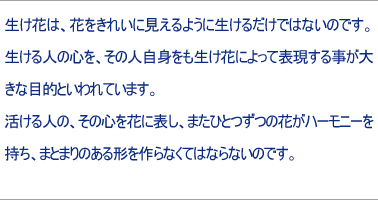 |
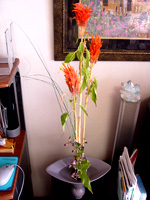 |
There
are many rules governing the arrangements in classical
ikebana. Luckily there are also a great variety
of styles including ‘freestyle’; definitely
less complicated and more in tune with a foreign
take on flower arrangement yet still trademark Japanese.
Does it sound like I know a little bit about this
rather interesting art? Let me acquaint you with
my learning process.
A couple of weeks ago, as I made my way to Kazumi
Shoin, a school specializing in ikebana and Japanese
calligraphy or ‘shuji’, I was busily
thinking about what would be the best and most appropriate
questions to ask the teacher of one of Japan’s
most historical arts. Images of students kneeling
on a hard wooden floor, gazes fixed intently on
the teacher as technique after technique was uttered
in rather severe tones kept on bubbling up in my
mind and I quickly became aware that, apart from
asking moderately dopey questions like, “What
kind of flowers do you use?” and “How
long does it take to get a firm grasp on the techniques
involved?”, I had relatively no idea about
ikebana and the beads of sweat on my forehead were
testimony to the fact. My apprehension decreased
only marginally as I arrived. Phew, an apartment
building (a rather nice one at that). Maybe this
won’t be as serious of an affair as I was
imagining… Or maybe it is a prestigious school
located inside a prestigious apartment!
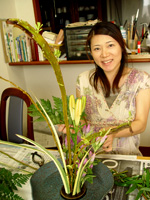 |
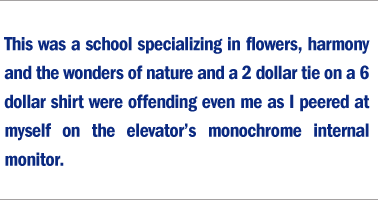 |
I gave the owner of the school a quick call to get
buzzed inside and away I went, meanwhile checking
my tie and cursing my lack of colour coordination
due to dry cleaning. This was a school specializing
in flowers, harmony and the wonders of nature and
a 2 dollar tie on a 6 dollar shirt were offending
even me as I peered at myself on the elevator’s
monochrome internal monitor.
After my short ride on the elevator to what I was
convinced would be another embarrassing encounter,
I was finally standing in front of Kazumi Shoin’s
entrance. “Looks like an apartment. Could
it just be a facade? Too late let’s press
the button”.
At the door I was greeted by a smiling, neatly dressed
(yet not formally), Japanese lady. Thinking I had
made a mistake, I quickly reconfirmed the appointment
with a cunning, “thanks for taking the time
to answer some questions about ikebana” statement.
I indeed had the right place and there was neither
a hard wooden floor to be seen nor a severe tone
to be heard. In fact, as I was graciously offered
a cup of tea and a seat, I was surprised to learn
that Kazumi Shoin, run by Kazumi Miyamoto, has more
of a chat club feel rather than a school for an
art form older than my shoes and bound by more rules
than the latest Pokemon card game.
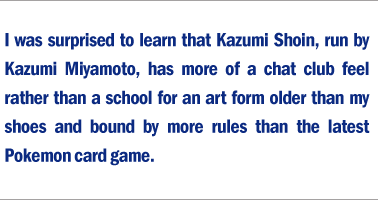 |
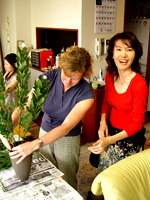 |
After gleaning some of the basics from Kazumi (which
I shared with you in the second passage) some of
the students started to arrive including an ultra
friendly Australian lady by the name Fiona who has
been studying ikebana (sometimes attempting a bit
of calligraphy as well) for about 6 months and who
told me she is interested in becoming a florist
at some stage in her life. I watched as she received
instruction from Kazumi on arranging flowers in
the Shouka style which requires an odd number of
flowers (in this case 7). Wanting to get a little
bit more technical, I asked about the way in which
the stems are prepared; random hacking of leaves
or was there a method? Fiona explained that traditionally
the practitioners of ikebana would place the arrangement
in the ‘tokonoma’ (a part of the Japanese
house reserved for ikebana or paintings) so the
side of the stem with the leaves would receive the
most direct sunlight.
Hmmm…More rules
More about ‘freestyle’ please.
Freestyle, as the name suggests, is limited by virtually
no rules. The exception is that each arrangement
should express movement; a sense of flow. This can
be aided by the use of wire to sculpt flowers, stems
or grasses; a practice not seen in the more traditional
styles of ikebana. Now, although in theory there
are no rules for freestyle, in practice it isn’t
quite true. Fiona alluded to the fact that some
unwritten rules seem to be in place. After finishing
an arrangement which she deemed a total success,
sensei Kazumi would “fine tune” the
position, setting, or spacing. In the end though,
Kazumi would be the first to admit it really is
about your own style.
So,
despite my ill-conceived pre-conceptions about what
Kazumi Shion was all about? I discovered that ikebana,
at least at Kazumi Shion, was for anybody interested
in having a chat, a laugh, expanding their horizons
and exercising their artistic flare. Anyone who
likes the sound of a cultural experience with all
the enjoyment of coffee with friends should give
Kazumi a call. She has no problem with English so
newcomers to Japan needn’t worry.
One
thing I should mention is, currently Kazumi Shion
is only accepting female students so, fellas you’ll
have to keep your fingers crossed for the future.
Interested?
Let me give you the details:
Ikebana
costs: FREE to join and ¥1,000 per 2 hour flower
arrangement lesson for.
Perhaps
Ikebana isn’t for you. Why not give calligraphy
a go? It’s a great way to become proficient
in writing Japanese.
Calligraphy
costs: ¥1,800 per lesson plus ¥300 for ink
(lasts about 6 months) and ¥50 for 20 sheets
of paper (each lesson students will usually use
about 20 sheets). All other equipment is provided
so you don’t need to bring anything else but
yourself.
Class
times: Tuesday 19:00 - 21:00
Wednesday 13:00 – 15:00
Thursday 10:00 – 12:00
Saturday 15:00 – 17:00
A
message from Kazumi: “We have about 20 students
at the moment, many of whom are foreign nationals
and whom are also students of Japanese. Each lesson
we aim to not only expand our knowledge of ikebana
(or calligraphy) but also to expand our students’
Japanese language ability. You will definitely have
a great time at our lessons.”
Location:
Sawakami Atsuta ku. Five minutes walk from Kanayama
Station.
Contact
details: 090-3300-1117 or kazumi33@cs.puon.net
 
|